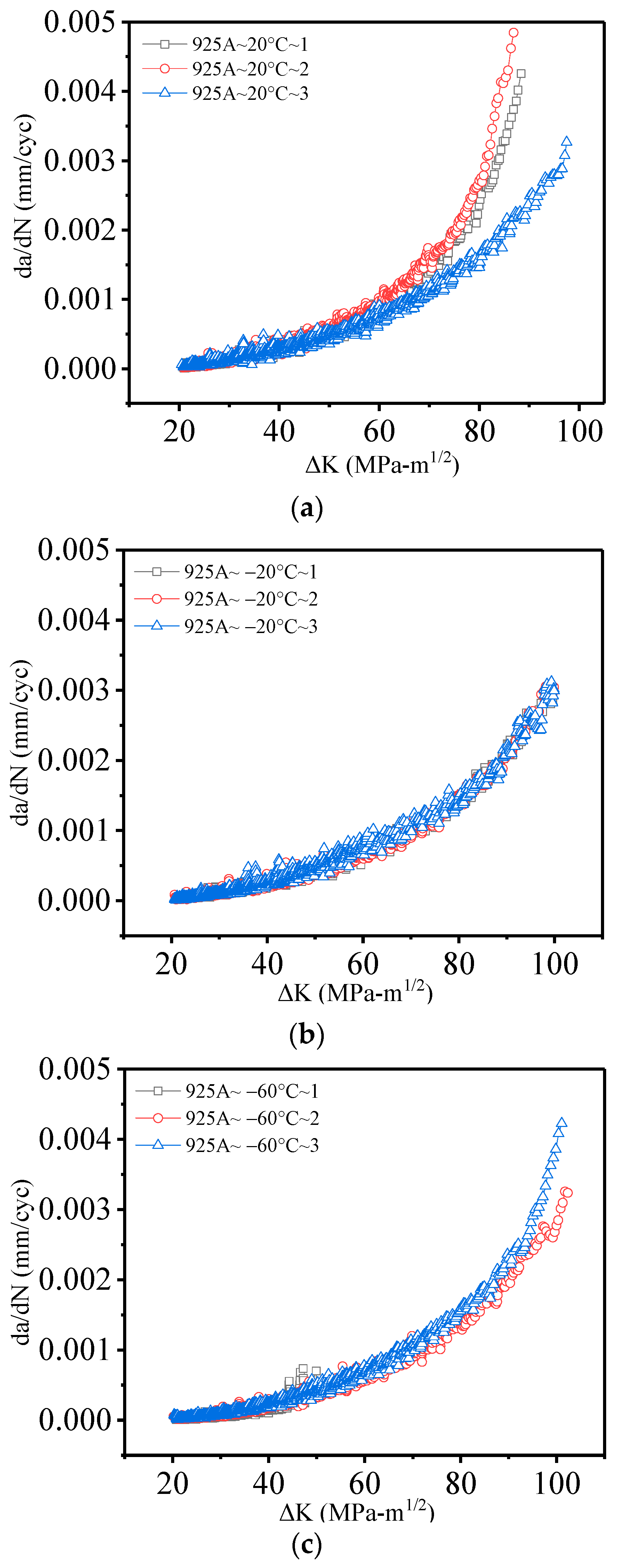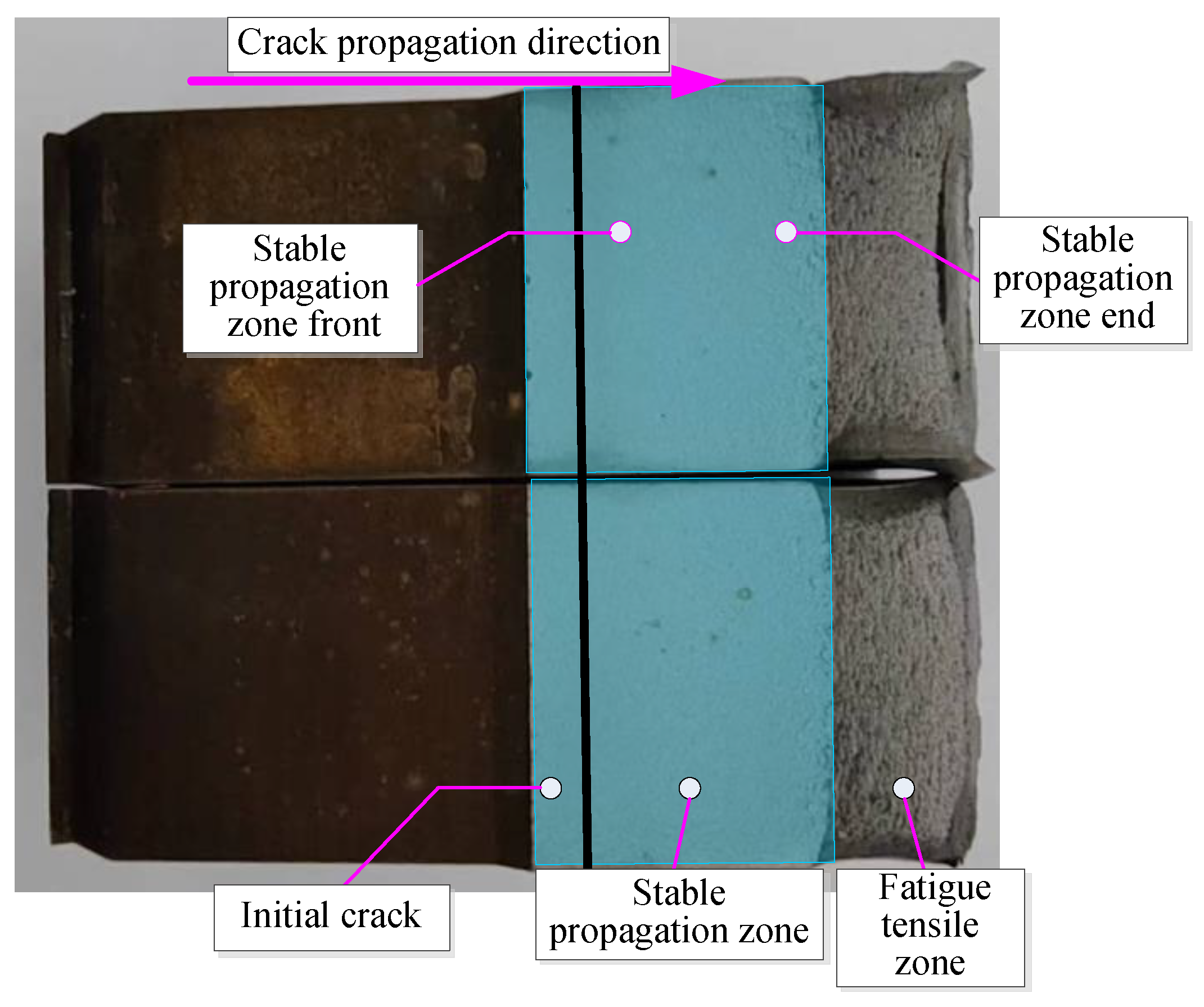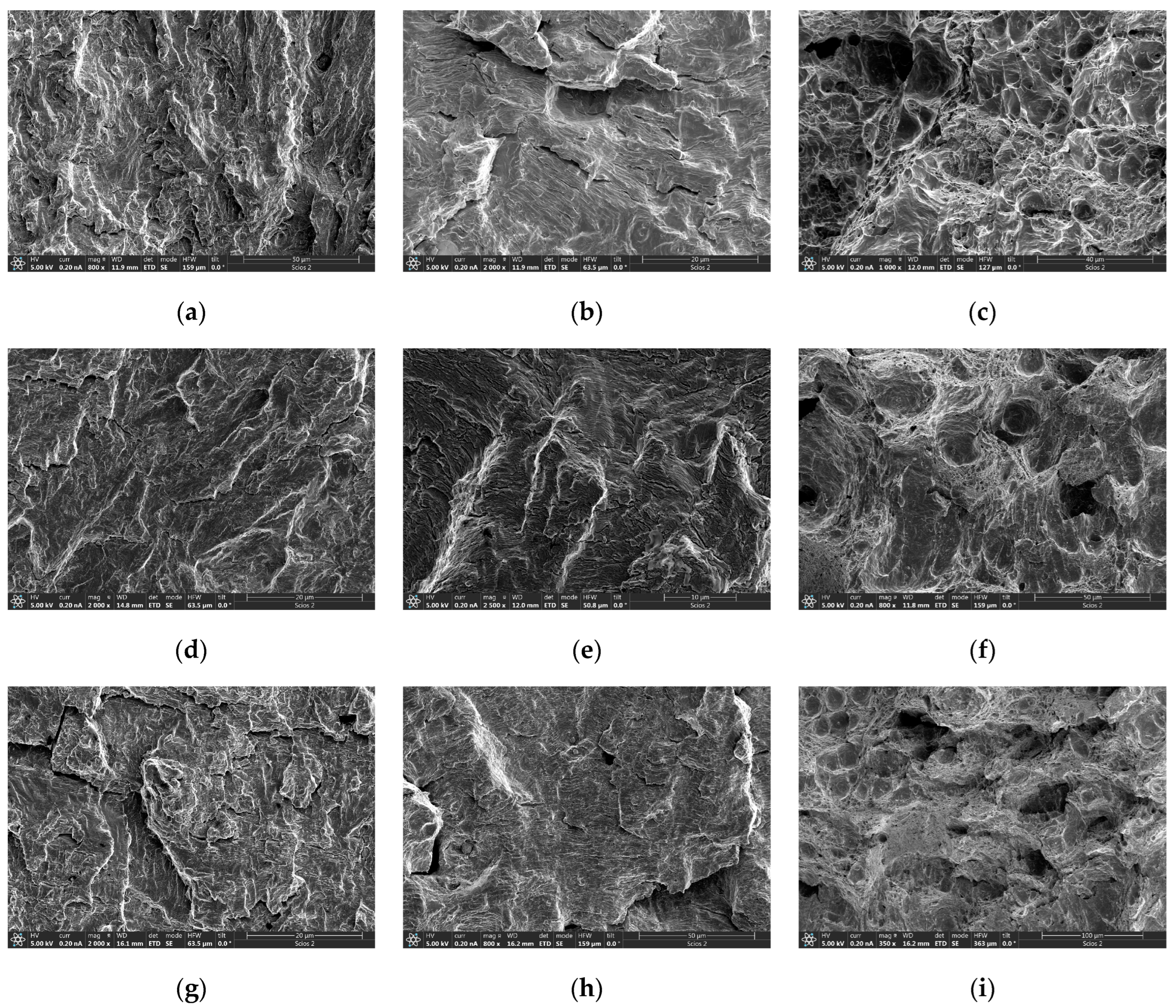Experimental Study on the Fatigue Crack Propagation Rate of 925A Steel for a Ship Rudder System
Abstract
:1. Introduction
2. Materials and Test Methods
2.1. Test Materials
2.2. Fatigue Crack Propagation Rate Experiment
3. Results and Discussion
3.1. Tensile and Impact Test
3.2. Fatigue Crack Propagation Rate Test
3.3. Effect of Low Temperature on Fatigue Crack Propagation Behavior
4. Morphological Analyses of the Fracture
5. Conclusions
- (1)
- The fatigue crack propagation rate of 925A steel was tested, and the a–N curve of 925A steel was obtained. The results showed that the service life of 925A steel increased with the decreasing temperature.
- (2)
- At stress intensity factor amplitudes ranging from 20 to 100 MPa-m1/2, 925A steel exhibited excellent resistance to fatigue crack propagation.
- (3)
- The macro fracture of the stable fatigue crack growth zone of the compact tensile specimen showed obvious cleavage fracture and morphological and ductile fracture characteristics. The measured crack growth rate was similar to that calculated by the Paris Law. The fitted Paris parameter could accurately describe the fatigue crack growth performance of 925A steel in this paper. The test data could provide a reference for the design of polar ships to resist low-temperature fatigue and cold brittle fracture.
- (4)
- Within the polar normal temperature range, 925A steel met the requirements of a low-temperature fatigue crack growth rate in the polar region. However, at extreme polar temperatures below −60 °C, preventing brittle failure has become the focus of fatigue design, and relevant research should be carried out in the future.
Author Contributions
Funding
Institutional Review Board Statement
Informed Consent Statement
Data Availability Statement
Acknowledgments
Conflicts of Interest
References
- Chen, J.; Kang, S.; Chen, C.; You, Q.; Du, W.; Xu, M.; Chen, J. Changes in Sea Ice and Future Accessibility Along the Arctic Northeast Passage. Glob. Planet. Chang. 2020, 195, 103319. [Google Scholar] [CrossRef]
- Yu, L.; Guo, W.; Chen, H.; Wu, Z.; Cao, C.; Li, X.; Chen, S. Fatigue Performance Analysis of an Underwater Vehicle Rudder Mechanism Considering Arctic Low Temperatures. Appl. Sci. 2024, 14, 1057. [Google Scholar] [CrossRef]
- Huang, J. Research on the Influence of Arctic Navigation on the Navigation Performance of Submarine. Ship Electron. Eng. 2020, 40, 62–66. [Google Scholar]
- Chen, S.; Guo, W.; Cao, C.; Huang, J.; Zhang, J.; Yu, L.; Chen, H. Fatigue Life Analysis of the Submarine Rudder Stock Mechanism at Arctic Low Temperatures. Appl. Sci. Eng. 2023, 13, 127. [Google Scholar] [CrossRef]
- ABS. Guide for Vessels Operating in Low-Temperature Environments; American Bureau of Shipping: Houston, TX, USA, 2015. [Google Scholar]
- GB/T 6398-2017; Standard Test Method for Fatigue Crack Growth Rates of Metallic Materials. Standards Press of China: Beijing, China, 2017. (In Chinese)
- Galatolo, R.; Lazzeri, R. Fatigue Crack Growth of Multiple Interacting Cracks: Analytical Models and Experimental Validation. Fatigue Fract. Eng. Mater. Struct. 2017, 41, 183–196. [Google Scholar] [CrossRef]
- Cavuoto, R.; Lenarda, P.; Misseroni, D.; Paggi, M.; Bigoni, D. Failure through Crack Propagation in Components with Holes and Notches: An Experimental Assessment of the Phase Field Model. Int. J. Solids Struct. 2022, 257, 111798. [Google Scholar] [CrossRef]
- Seifi, R.; Ghadimian, O.; Ranjbaran, M. Study on Life and Path of Fatigue Cracks in Multiple Site Damage Plates. Int. J. Fatigue 2015, 80, 449–458. [Google Scholar] [CrossRef]
- Anasori, B.; Saillot, F.; Stanley, D.; Awerbuch, J.; Tan, T. Fatigue Crack Growth in Aluminum Lithium Riveted Lap Joints. Procedia Eng. 2014, 74, 413–416. [Google Scholar] [CrossRef]
- Alqahtani, I.; Starr, A.; Khan, M. Investigation of the Combined Influence of Temperature and Humidity on Fatigue Crack Growth Rate in Al6082 Alloy in a Coastal Environment. Materials 2023, 16, 6833. [Google Scholar] [CrossRef]
- Song, W.; Man, Z.; Xu, J.; Wang, X.; Liu, C.; Zhou, G.; Berto, F. Fatigue Crack Growth Behavior of Different Zones in an Overmatched Welded Joint Made with D32 Marine Structural Steel. Metals 2023, 13, 535. [Google Scholar] [CrossRef]
- Braun, M.; Fischer, C.; Baumgartner, J.; Hecht, M.; Varfolomeev, I. Fatigue Crack Initiation and Propagation Relation of Notched Specimens with Welded Joint Characteristics. Metals 2022, 12, 615. [Google Scholar] [CrossRef]
- Guo, Y.; Chen, F.; Liu, B.; Yu, H.; Deng, H. Effect of Stress Ratio and Evaluation of Crack Sizes on Very-High-Cycle-Fatigue Crack Propagation Life Prediction of Carburized Cr-Ni Steel. Metals 2022, 12, 1485. [Google Scholar] [CrossRef]
- Lv, C.; Wang, K.; Zhao, X.; Wang, F. Damage-Accumulation-Induced Crack Propagation and Fatigue Life Analysis of a Porous LY12 Aluminum Alloy Plate. Materials 2023, 17, 192. [Google Scholar] [CrossRef] [PubMed]
- Hu, J.; Li, X.; Zhao, Q.; Chen, Y.; Yang, K.; Wang, Q. An Overview on Fatigue of High-Entropy Alloys. Materials 2023, 16, 7552. [Google Scholar] [CrossRef] [PubMed]
- Zong, L.; Guo, S.; Liao, X.; Wang, X.; Yang, H. Experimental Study on Fatigue Crack Propagation Rate of Q690D High-Strength Steel. J. Build. Struct. 2023, 44, 217–224. [Google Scholar] [CrossRef]
- Zong, L.; Shi, G.; Wang, Y.; Liao, X.; Yu, X. Experimental Study on Fatigue Crack Behavior of Bridge Steel WNQ570 Base Metal and Butt Weld. Eng. Mech. 2016, 33, 45–51. [Google Scholar] [CrossRef]
- Zong, L.; Shi, G.; Wang, Y.; Liao, X. Experimental Study on Fatigue Crack Propagation Rate of Q345qd Bridge Steel. China Railw. Sci. 2015, 36, 37–44. [Google Scholar] [CrossRef]
- Wang, Y.; Liao, X.; Jia, D.; Shi, Y. Overview of Research Progress for the Low-Temperature Fatigue Performance of Steel Structures. Prog. Steel Build. Struct. 2018, 20, 1–11. [Google Scholar] [CrossRef]
- Liao, X.; Wang, Y.; Shi, Y.; Chen, H. Experimental Study on The Fatigue Crack Growth Behavior of Bridge Steel Q345qD at Low Temperatures. Eng. Mech. 2018, 35, 85–91. [Google Scholar] [CrossRef]
- Tong, L.; Ren, Z.; Jing, S.; Niu, L. Experimental Study on Fatigue Crack Growth Rate of High Strength Structural Steel Series. Eng. Mech. 2020, 37, 191–201. [Google Scholar] [CrossRef]
- Fan, Y.; Su, H.; Chen, K.; Zhang, L.; Guo, X. Corrosion Fatigue Crack Growth Behavior of Austenitic Stainless Steels in Seawater Environment. Corros. Prot. 2020, 41, 67–74. [Google Scholar] [CrossRef]
- Zhong, Y.; Shao, Y.; Gao, X.; Luo, X.; Zhu, H.; Yang, D. Effect of Stress Ratio on Fatigue Crack Growth Rate of EH36 Steel in the Marine Corrosive Environment. Mater. Rep. 2023, 37, 192–198. [Google Scholar] [CrossRef]
- Liu, J.; Jin, Y.; Yang, L.; Ji, Y.; Wang, X. Study on Fatigue Life of Welds with Defects in Large Transformer Tank. Hot Work. Technol. 2021, 50, 145–149. [Google Scholar] [CrossRef]
- Chen, B.; Ji, Y.; Liang, Y.; Wang, X. Fatigue Life Analysis of Fillet Welds of Transformer Oil Tank with Welding Defects. J. Mech. Strength 2023, 45, 209–217. [Google Scholar] [CrossRef]
- Xu, L.; Zhang, R.; Zhao, S. Study on Fatigue Crack Growth Rate Based on Elastic-Plastic Mechanics. J. Mech. Strength 2023, 45, 607–612. [Google Scholar] [CrossRef]
- Bai, L.; Shao, F.; Gao, L.; Xu, Q. Analysis on Growth Rate of Fatigue Crack of Welded Structures Based on Multi-Factor. Chin. J. Comput. Mech. 2020, 37, 349–354. [Google Scholar] [CrossRef]
- Wang, K.; Huang, X.; Li, Y.; Zhang, S.; Bian, C.; Gao, L. Test and Prediction of Fatigue Crack Growth Rate of Titanium Alloy Materials. Ship Sci. Technol. 2021, 43, 14–18. [Google Scholar] [CrossRef]
- Wang, K.; Wu, L.; Li, Y.; Qin, C. Experimental Study on Low Temperature Fatigue Performance of Polar Icebreaking Ship Steel. Ocean. Eng. 2020, 216, 107789. [Google Scholar] [CrossRef]
- Mendes, P.; Monteiro, M.; Correia, J.; Vieira, M.; Reis, A.; Horas, C.; Jesus, A. High-cycle rotating-bending fatigue performance of S690QL welded joints. J. Constr. Steel Res. 2024, 214, 108488. [Google Scholar] [CrossRef]
- Anoop, C.; Singh, R.; Kumar, R.; Jayalakshmi, M.; Antony, P.; Thomas, T.; Murty, K. A review on steels for cryogenic applications. Mater. Perform. Charact. 2021, 10, 16–88. [Google Scholar] [CrossRef]
- Ferreira, F.; Neto, D.; Jesus, J.; Prates, P.; Antunes, F. Numerical Prediction of the Fatigue Crack Growth Rate in SLM Ti-6Al-4V Based on Crack Tip Plastic Strain. Metals 2020, 10, 1133. [Google Scholar] [CrossRef]
- Xin, H.; Veljkovic, M. Residual Stress Effects on Fatigue Crack Growth Rate of Mild Steel S355 Exposed to Air and Seawater Environments. Mater. Des. 2020, 193, 108732. [Google Scholar] [CrossRef]
- Zhao, W.; Feng, G.; Zhang, M.; Ren, H.; Sinsabvarodom, C. Effect of Low Temperature on Fatigue Crack Propagation Rates of DH36 Steel and Its Butt Weld. Ocean. Eng. 2020, 196, 106803. [Google Scholar] [CrossRef]
- Park, J.Y.; Kim, B.K.; Nam, D.G.; Kim, M.H. Effect of Nickel Contents on Fatigue Crack Growth Rate and Fracture Toughness for Nickel Alloy Steels. Metals 2022, 12, 173. [Google Scholar] [CrossRef]
- Steimbreger, C.; Gubeljak, N.; Vuherer, T.; Enzinger, N.; Ernst, W.; Chapetti, M. Effect of Welding Processes on the Fatigue Behaviour of Ultra-High Strength Steel Butt-Welded Joints. Eng. Fract. Mech. 2022, 275, 108845. [Google Scholar] [CrossRef]
- Al-Rubaie, K.; Barroso, E.; Godefroid, L. Fatigue Crack Growth Analysis of Pre-Strained 7475–T7351 Aluminum Alloy. Int. J. Fatigue 2006, 28, 934–942. [Google Scholar] [CrossRef]
- Al-Rubaie, K.; Godefroid, L.; Lopes, J. Statistical Modeling of Fatigue Crack Growth Rate in Inconel Alloy 600. Int. J. Fatigue 2007, 29, 931–940. [Google Scholar] [CrossRef]
- Al-Rubaie, K.; Barroso, E.; Godefroid, L. Statistical Modeling of Fatigue Crack Growth Rate in Pre-Strained 7475-T7351 Aluminum Alloy. Mater. Sci. Eng. A 2008, 486, 585–595. [Google Scholar] [CrossRef]
Disclaimer/Publisher’s Note: The statements, opinions, and data contained in all publications are solely those of the individual author(s) and contributor(s) and not of MDPI and/or the editor(s). MDPI and/or the editor(s) disclaim responsibility for any injury to people or property resulting from any ideas, methods, instructions, or products referred to in the content. |






| C | Si | Mn | S | P | Cr | Ni | Mo | V | Cu |
|---|---|---|---|---|---|---|---|---|---|
| 0.13~0.18 | 0.17~0.37 | 0.30~0.60 | ≤0.015 | ≤0.020 | 0.90~1.20 | 2.60~3.00 | 0.20~0.27 | 0.03~0.08 | ≤0.25 |
| Temperature/T (°C) | Tensile Strength/σb (MPa) | Offset Yield Strength/σ0.2 (MPa) | Impact Energy/Akv (J) | Elastic Modulus/E (GPa) | Poisson’s Ratio/ν |
|---|---|---|---|---|---|
| 20 | 636 | 519 | 186 | 201 | 0.26 |
| −20 | 633 | 515 | 178 | 194 | 0.27 |
| −60 | 666 | 590 | 160 | 186 | 0.25 |
| Temperature/°C | Ratio | Frequency/Hz | logC | m | R2 |
|---|---|---|---|---|---|
| 20 | 0.1 | 10 | −8.55301 | 3.11012 | 0.97293 |
| 20 | 0.1 | 10 | −8.36779 | 2.95344 | 0.96699 |
| 20 | 0.1 | 10 | −8.54219 | 3.03567 | 0.97727 |
| −20 | 0.1 | 10 | −7.94087 | 2.68417 | 0.97673 |
| −20 | 0.1 | 10 | −7.97326 | 2.70931 | 0.97313 |
| −20 | 0.1 | 10 | −8.36779 | 2.95344 | 0.96699 |
| −60 | 0.1 | 10 | −9.85266 | 3.79749 | 0.94281 |
| −60 | 0.1 | 10 | −8.43396 | 2.95526 | 0.97634 |
| −60 | 0.1 | 10 | −8.54219 | 3.03567 | 0.97727 |
Disclaimer/Publisher’s Note: The statements, opinions and data contained in all publications are solely those of the individual author(s) and contributor(s) and not of MDPI and/or the editor(s). MDPI and/or the editor(s) disclaim responsibility for any injury to people or property resulting from any ideas, methods, instructions or products referred to in the content. |
© 2024 by the authors. Licensee MDPI, Basel, Switzerland. This article is an open access article distributed under the terms and conditions of the Creative Commons Attribution (CC BY) license (https://creativecommons.org/licenses/by/4.0/).
Share and Cite
Yu, L.; Guo, W.; Cao, C.; Li, M.; Wu, Z.; Wang, T.; Chen, H.; Pan, X. Experimental Study on the Fatigue Crack Propagation Rate of 925A Steel for a Ship Rudder System. Materials 2024, 17, 1808. https://doi.org/10.3390/ma17081808
Yu L, Guo W, Cao C, Li M, Wu Z, Wang T, Chen H, Pan X. Experimental Study on the Fatigue Crack Propagation Rate of 925A Steel for a Ship Rudder System. Materials. 2024; 17(8):1808. https://doi.org/10.3390/ma17081808
Chicago/Turabian StyleYu, Li, Wenyong Guo, Chenghao Cao, Min Li, Zhe Wu, Te Wang, Hantao Chen, and Xinglong Pan. 2024. "Experimental Study on the Fatigue Crack Propagation Rate of 925A Steel for a Ship Rudder System" Materials 17, no. 8: 1808. https://doi.org/10.3390/ma17081808






